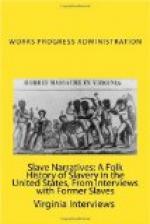“I could read and write when I was 12 years old. I was taught by. the teacher who was the governess for the Randolph children. Mother could also read and write. There was no church on the plantation; the slaves attended church on the next plantation, where the owner had a large slave church, he was a Baptist preacher, I attended the white church with the Randolph children. I was generally known and called Jim Randolph. I was baptised by the white Baptist minister and christened by a Methodist minister.
“There was little trouble between the white and blacks, you see I was one of the children of the house, I never came in contact much with other slaves. I was told that the slaves had a drink that was made of corn and rice which they drank. The overseers sometimes themselves drank it very freely. On holidays and Sundays the slaves had their times, and I never knew any difference as I was treated well by my father and did not associate with the other slaves.
“In the year of 1865, I left South Carolina, went to Washington, entered Howard University 1868, graduated in 1873, taught schools in Virginia, North Carolina and Maryland, retired 1910. Since then I have been connected with A.M.E. educational board. Now I am home with my granddaughter, a life well spent.
“One of the songs sung by the slaves on the plantation I can remember a part of it. They sang it with great feeling of happiness——
Oh where shall we go when de great day
comes
An’ de blowing of de trumpets and
de bangins of de drums
When General Sherman comes.
No more rice and cotton fields
We will hear no more crying
Old master will be sighing.
“I can’t remember the tune, people sang it according to their own tune.”
Maryland
Sept. 23, 1937
Rogers
Mary Moriah Anne Susanna James,
Ex-slave.
Reference: Personal interview with Mary James,
ex-slave,
Sept.
23, 1937, at her home, 618 Haw St., Baltimore, Md.
“My father’s name was Caleb Harris James, and my mother’s name was Mary Moriah. Both of them were owned by Silas Thornton Randorph, a distant relative of Patrick Henry. I have seen the picture of Patrick Henry many a time in the home place on the library wall. I had three sisters and two brothers. Two of my sisters were sold to a slave dealer from Georgia, one died in 1870. One brother ran away and the other joined the Union Army; he died in the Soldiers’ Home in Washington in 1932 at the age of 84.
“How let me ask you, who told you about me? I knew that a stranger was coming, my nose has been itching for several days. How about my home life in Virginia, we lived on the James River in Virginia, on a farm containing more than 8,000 acres, fronting 3-1/2 miles on the river, with a landing where boats used to come to load tobacco and unload goods for the farm.




